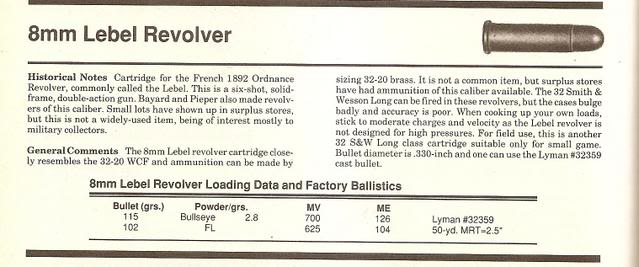aarondhgraham
New member
1892 Lebel 8mm Revolver?

Just curious is all,,,
.

Just curious is all,,,
.

Also note anything older than 1900 is an antique and does not require any FFL for transfer
You seem to be mixing up C&R firearms and antiques. Let's step back a second and go over this carefully.Winchester_73, please excuse my lack of knowledge here, so you mean that an original cap and ball that is modified would not be C&R, but say, an original 1880's SAA would be C&R as is? If so, that would mean that the modification itself disqualifies it?
Pay particular attention to the "ands" and "ors". If the gun was made before 1/1/1899, it falls under paragraph (A), and it does not matter whether it has been converted from cap-and-ball to metallic-cartridge ammunition. Its age and therefore its status do not change. The conversion only matters if the gun is a replica that falls under paragraph (B) or a blackpowder muzzleloader under (C). (If one modifies a replica or a muzzleloader to fire metallic-cartridge ammunition, one has legally become a "firearms manufacturer", and a whole 'nother set of laws come into play.)(16) The term ``antique firearm'' means--
(A) any firearm (including any firearm with a matchlock, flintlock, percussion cap, or similar type of ignition system) manufactured in or before 1898; or
(B) any replica of any firearm described in subparagraph (A) if such replica--
(i) is not designed or redesigned for using rimfire or conventional centerfire fixed ammunition, or
(ii) uses rimfire or conventional centerfire fixed ammunition which is no longer manufactured in the United States and which is not readily available in the ordinary channels of commercial trade; or
(C) any muzzle loading rifle, muzzle loading shotgun, or muzzle loading pistol, which is designed to use black powder, or a black powder substitute, and which cannot use fixed ammunition. For purposes of this subparagraph, the term ``antique firearm'' shall not include any weapon which incorporates a firearm frame or receiver, any firearm which is converted into a muzzle loading weapon, or any muzzle loading weapon which can be readily converted to fire fixed ammunition by replacing the barrel, bolt, breechblock, or any combination thereof.
IIRC the exact reason why the cylinder swings to the right is lost to history, but the theory is that it was designed that way for the same reason that a Colt SAA's reloading gate is on the right- a cavalryman would hold the revolver together with the horse's reins in the left hand while loading fresh cartridges with the right hand.The Modele 1892 French Ordnance Revolver, aka the Lebel, is a solid, well made and reliable revolver... It is (AFAIK) unique in having a swing out cylinder that swings to the right.

